Kid-safe mosquito sprays combine natural repellents with gentle carriers. You’ll need lavender and lemon eucalyptus essential oils (safe for kids over 2), witch hazel, and distilled water. Mix 5 drops of each oil with 1 oz each of witch hazel and water in a spray bottle. Always do a patch test first and avoid sensitive areas. Store in dark bottles and refrigerate for freshness. The simple recipe below offers effective protection without harsh chemicals your little ones don’t need.
Understanding Mosquito Risks for Children
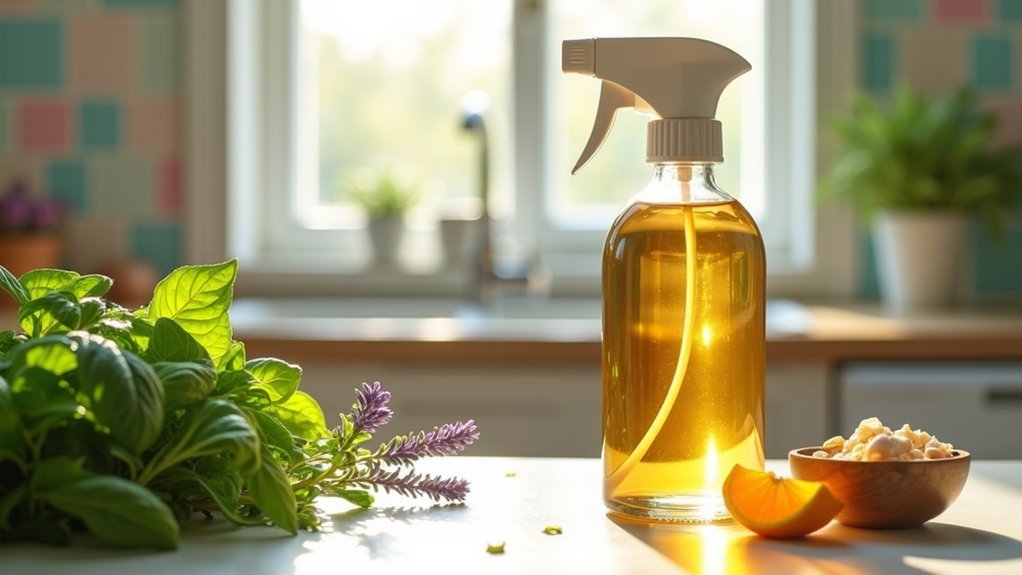
While summer brings opportunities for outdoor adventures, it also introduces significant mosquito risks for your children. Their developing immune systems make them particularly vulnerable to mosquito-borne illnesses like West Nile and Zika viruses, especially during dawn and dusk when mosquitoes are most active.
Children under two face higher risks of adverse reactions to chemical repellents like DEET, according to CDC reports. This makes kid-safe mosquito sprays containing natural ingredients essential alternatives for protection.
These safer options reduce chemical exposure while still effectively repelling insects.
When your children play outdoors during peak mosquito seasons, they’re not just facing temporary discomfort from bites – they’re potentially exposed to serious health risks.
Proper protection balances effective mosquito deterrence with your child’s safety needs.
Essential Ingredients for Child-Safe Repellents
Creating a truly child-safe mosquito repellent starts with selecting the right ingredients that balance effectiveness with gentleness.
Lavender and lemon eucalyptus essential oils stand out as powerful yet kid-safe options for children over age 2, offering natural protection without harsh chemicals.
To make your own mosquito repellent, combine 5 drops of lavender essential oil with 1 oz each of witch hazel and distilled water.
This diluted mixture provides effective protection while respecting your child’s sensitive skin.
Avoid potentially irritating oils like tea tree or cinnamon, which work better for adults than little ones.
Always store your homemade mosquito repellents in child-proof containers and apply sparingly, avoiding broken skin, eyes, and mouth.
Remember to conduct a patch test first to check for any allergic reactions.
The Science Behind Natural Mosquito Deterrents
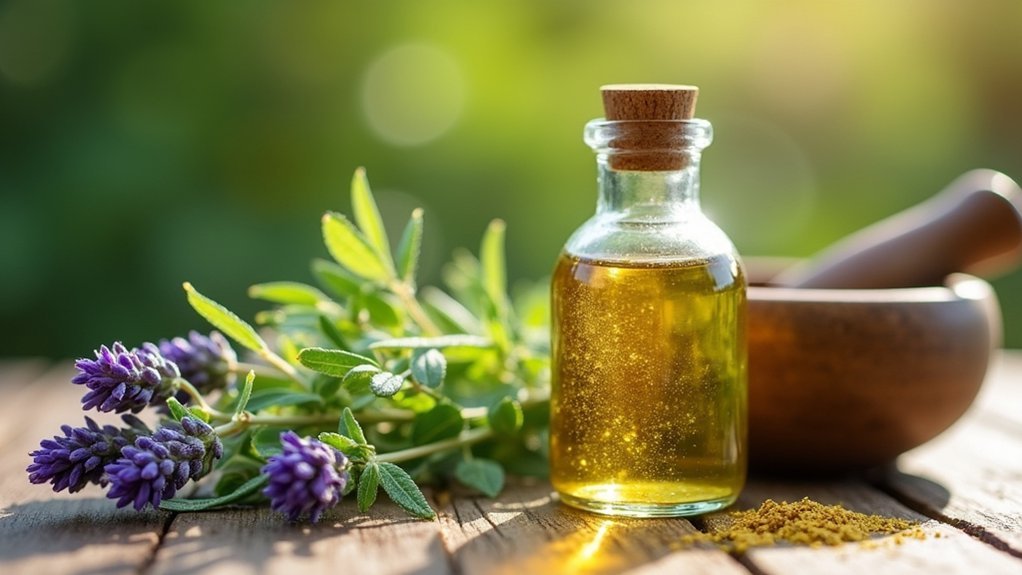
Plant-based mosquito repellents work by exploiting mosquitoes’ sensitive olfactory systems with compounds they find offensive.
Essential oils like lemon eucalyptus and lavender contain active ingredients that effectively mask your child’s natural scent, creating an invisible barrier that confuses these biting insects.
You’ll find these natural solutions particularly appealing because research shows they can provide up to 95% protection when properly formulated, though you’ll need to reapply them more frequently than synthetic alternatives.
Plant-Based Protection Principles
Nature provides powerful alternatives to chemical mosquito repellents through essential oils that offer scientifically proven protection. When you apply plant-based protection to your child’s skin and clothing, you’re harnessing compounds that mosquitoes naturally avoid.
Lemon eucalyptus oil stands out with its impressive 95% protection rate for several hours—it’s even CDC-approved as a natural repellent.
- Essential oil barriers – Citronella, lavender, and eucalyptus create invisible shields around your child through their potent aromatic compounds.
- Soybean oil formulations – Products containing just 2% soybean oil deliver substantial protection without harsh chemicals.
- Thyme oil solutions – Provides up to 91% effectiveness against specific mosquito species while remaining gentle on sensitive skin.
While you’ll need to reapply natural repellents more frequently than DEET, they’re considerably less likely to cause skin irritation.
Essential Oil Efficacy
While many parents assume natural solutions lack scientific backing, essential oils have undergone rigorous testing that confirms their mosquito-repelling abilities.
Research shows lemon eucalyptus oil at 32% concentration provides over 95% protection for up to three hours, making it a standout natural mosquito repellent.
You’ll find lavender oil isn’t just pleasantly scented—animal studies confirm it’s effective against mosquitoes while offering additional therapeutic benefits.
Similarly, cinnamon oil kills mosquito eggs and repels adults, particularly Asian tiger mosquitoes.
Thyme oil delivers impressive 91% protection against malarial mosquitoes at just 5% concentration.
These essential oils offer safer alternatives to chemical repellents, though you’ll need to reapply them more frequently.
The science is clear: natural solutions can effectively shield your children from mosquitoes without harsh chemicals.
Step-by-Step Recipe for Homemade Kid-Friendly Spray
Creating your kid-friendly mosquito spray requires just a few simple ingredients you’ll likely have at home: witch hazel, distilled water, and lavender and lemon essential oils.
Always mix your spray in a clean bottle, shaking well before each use to blend the natural repellent properties evenly.
Before applying widely on your child’s skin, test a small patch first to guarantee there’s no sensitivity to any of the ingredients.
Simple Ingredients Guide
Just a few simple ingredients from your pantry and local health store can create an effective mosquito repellent that’s safe for children.
This gentle bug spray uses natural elements that won’t irritate sensitive skin while still keeping those pesky mosquitoes at bay.
- Base Solution – Combine equal parts witch hazel (1 oz) and distilled water (1 oz) to create the foundation of your spray, providing the perfect carrier for the essential oils.
- Essential Oils – Add 5 drops each of lavender and lemon essential oils, known for their natural mosquito-repelling properties.
- Storage Container – Pour your mixture into a small, travel-sized spray bottle for easy application during outdoor adventures.
Always perform a patch test before applying broadly to verify compatibility with your child’s skin.
Mixing Safety First
Now that you’ve gathered your ingredients, let’s focus on the proper mixing technique to guarantee your homemade mosquito spray is both safe and effective for children.
Start by combining 1 ounce of witch hazel with 1 ounce of distilled water in your spray bottle to create a gentle base that’s safe for kids.
Add 5 drops each of lavender and lemon essential oils, which naturally repel mosquitoes without harsh chemicals.
Always shake the bottle thoroughly before each use to distribute the ingredients evenly.
Before you apply on the skin, perform a patch test on a small area to check for any reactions.
When using on your child’s face, spray onto your hands first, then gently dab on their skin, avoiding the eye area.
Store your mixture in a cool, dark place between uses.
Testing Before Application
Before applying your newly mixed mosquito spray to your child’s entire body, it’s essential to conduct a proper skin test to guarantee safety. This is especially important when using essential oils, as children’s sensitive skin may react differently than adults’.
Follow these simple steps for testing:
- Apply a small amount of the spray to your child’s inner wrist or elbow area, which typically has more sensitive skin similar to their face and neck.
- Wait at least 30 minutes and watch for any redness, itching, or irritation that might indicate a sensitivity to the lavender or lemon essential oil.
- If no reaction occurs, you can confidently use the spray on other parts of your child’s body, avoiding eyes, mouth, and any cuts or irritated areas.
Carrier Oils and Bases That Work Best for Sensitive Skin
The foundation of any kid-safe mosquito spray lies in choosing the right carrier oils and bases that protect sensitive skin. When mixing essential oils for your DIY repellent, you’ll need gentle bases that dilute potent ingredients while adding their own skin benefits.
| Carrier Base | Benefits for Sensitive Skin |
|---|---|
| Coconut Oil | Deeply moisturizes while creating a protective barrier |
| Witch Hazel | Natural astringent that soothes irritation |
| Aloe Vera Gel | Provides cooling, anti-inflammatory effects |
| Sunflower Oil | Lightweight, hypoallergenic, won’t clog pores |
Always select carrier oils free from synthetic fragrances and harsh chemicals. Jojoba and sweet almond oil are excellent alternatives that closely mimic your child’s natural skin oils, reducing the chance of reactions while effectively dispersing essential oils throughout your homemade mosquito spray.
Safe Essential Oil Combinations and Dilution Ratios
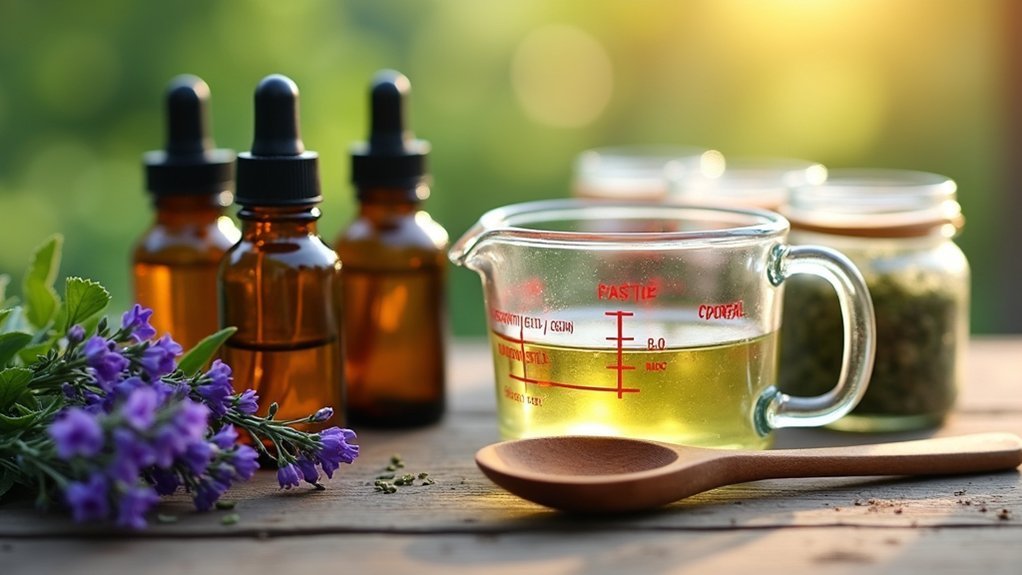
When making mosquito spray for your children, you’ll need to follow specific safety guidelines for essential oils, particularly avoiding concentrated formulas for kids under 2.
You can create a gentle yet effective repellent by combining 5 drops each of lavender and lemon essential oils with 1 ounce of witch hazel and 1 ounce of distilled water.
Always maintain the 1:10 ratio of essential oil to carrier liquid and test the spray on a small patch of skin before full application.
Essential Oil Safety Guidelines
Safely diluting essential oils stands as an essential first step when creating kid-friendly mosquito repellents at home.
When working with children over 2 years old, stick to gentle options like lavender and lemon oils, and avoid potentially irritating oils such as peppermint and cinnamon. Always dilute properly—use only 1-2 drops of essential oil per teaspoon of carrier oil for topical applications on children.
Before applying your homemade spray, follow these critical safety steps:
- Perform a patch test on a small area of your child’s skin and wait 24 hours to check for any skin irritation or allergic reaction.
- Properly dilute essential oils using the 5-5-1-1 formula: 5 drops each of lavender and lemon oils per 1 ounce each of witch hazel and distilled water.
- Store your homemade repellent in a dark glass bottle away from direct sunlight and children’s reach.
Proper Dilution Ratios
Creating safe mosquito sprays for children requires precise dilution measurements that protect sensitive skin while maintaining effectiveness.
For young children, always maintain essential oils at a 1-2% concentration—approximately 6-12 drops per ounce of carrier liquid.
When using lavender and lemon oils, which are particularly kid-friendly, mix 5 drops of each with one ounce of witch hazel or distilled water.
For stronger oils like eucalyptus or citronella, use just 1 drop per 2-3 ounces of carrier to guarantee safety while still repelling mosquitoes.
Testing Your Homemade Spray for Effectiveness
Three simple methods can help you evaluate whether your homemade mosquito repellent actually works.
After you’ve mixed your kid-safe solution, it’s essential to determine its effectiveness before relying on it to protect your children.
- Apply your spray to one arm and a commercial repellent to the other, then count mosquito landings on each during a 15-minute outdoor test at dusk.
- Recruit family members to try both your homemade spray and no protection in your backyard, recording bite counts after 30 minutes.
- Create a testing grid in your yard with treated and untreated sections, observing where mosquitoes concentrate during peak activity times.
For the most accurate testing results, perform these evaluations during dawn or dusk when mosquitoes are most active.
Your homemade spray’s effectiveness will vary based on the essential oils used.
When to Apply and How Often to Reapply
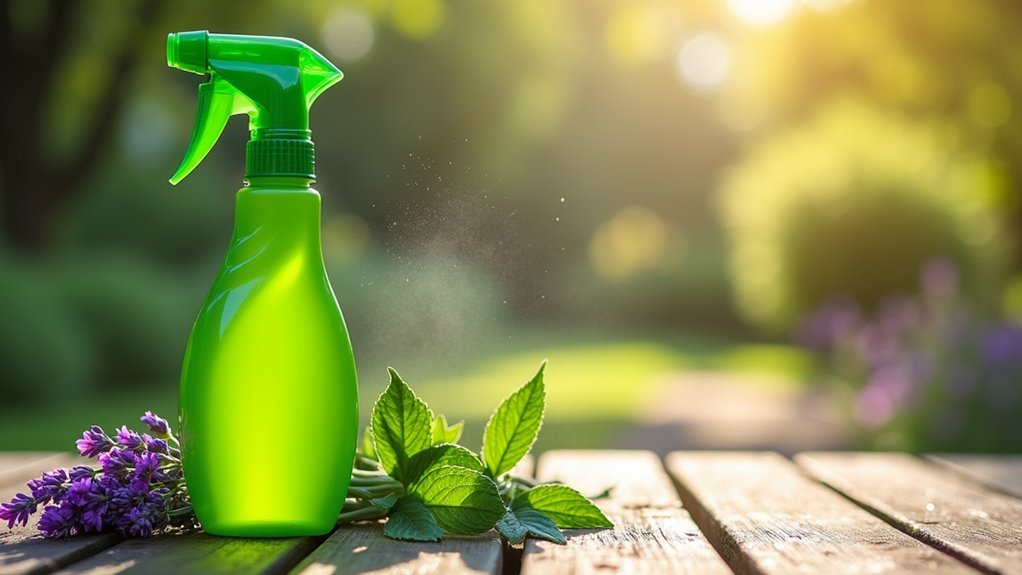
Timing your mosquito spray application properly can make all the difference in protecting your children from irritating bites.
Apply your kid-safe repellent before heading outdoors, particularly during peak mosquito activity from dusk to dawn.
For store-bought sprays, reapply every 2-4 hours as directed on the label. If your children are swimming or sweating, you’ll need to reapply more frequently to maintain protection.
Always follow manufacturer instructions for safe application rates.
With homemade sprays, be extra vigilant about effectiveness. Test on a small skin area first, then apply before outdoor activities.
If you notice mosquitoes still landing on your child despite the spray, it’s time to reapply.
Remember that consistent coverage is key to keeping your little ones safe and bite-free throughout your outdoor adventures.
Storage Tips and Shelf Life of DIY Mosquito Sprays
Once you’ve properly applied your kid-safe mosquito spray, proper storage becomes your next priority. Your homemade mosquito spray typically lasts 1-3 months when stored correctly, but you can maximize its shelf life with a few simple steps.
- Use dark or opaque bottles – These protect essential oils from light exposure that accelerates degradation of active ingredients.
- Label with creation date – Always mark when you made the spray to track freshness and guarantee safe usage.
- Refrigerate when possible – Cool temperatures slow the breakdown of natural ingredients, extending efficacy.
Watch for signs of spoilage like off smells, color changes, or ingredient separation. If you notice any of these warning signs, it’s time to discard your spray and whip up a fresh batch.
Age-Appropriate Formulations for Babies, Toddlers, and Older Kids
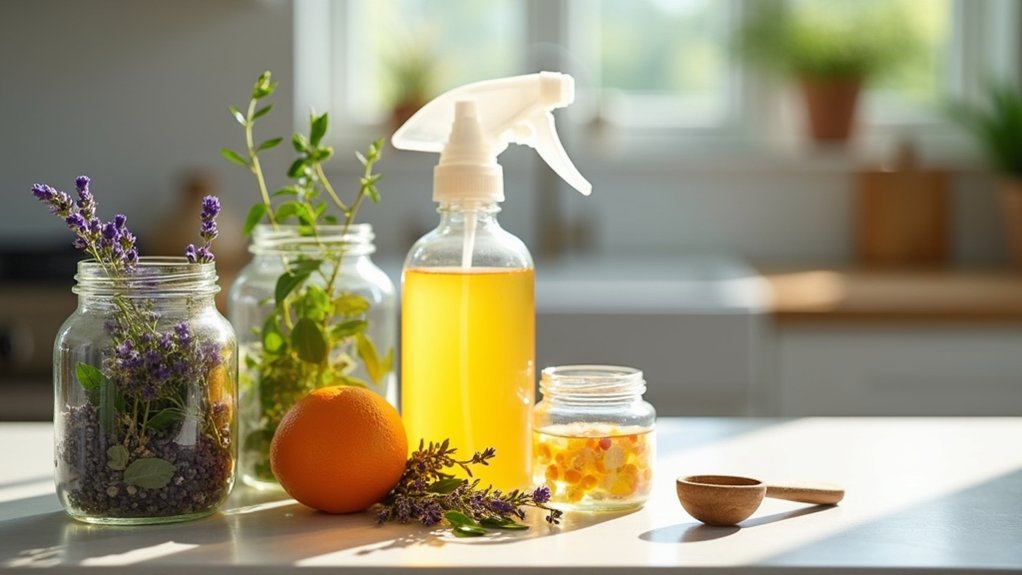
When creating mosquito protection for children, safety requirements change dramatically with age. For babies under two, avoid essential oils completely due to their sensitive skin and potential for adverse reactions.
Toddlers between 2-5 years can safely use diluted formulations containing gentle natural ingredients like lavender and lemon, but keep concentrations at 1-2% maximum to prevent irritation.
For older children, consider age-appropriate formulations with natural repellents such as citronella and eucalyptus, but always choose products specifically labeled for their age group.
School-age children benefit from natural repellents like citronella and eucalyptus, but verify age-appropriate labeling before application.
Before applying any homemade spray, perform a patch test regardless of your child’s age.
Your DIY repellents should prioritize gentle natural ingredients rather than harsh chemicals like DEET, ensuring effective protection without compromising your child’s safety.
Common Reactions and How to Avoid Them
Even natural mosquito repellents can trigger reactions in children, with skin redness often appearing in patchy clusters on exposed areas.
You’ll need to watch for citrus sensitivity signs including increased photosensitivity or bright red hives, especially after sun exposure.
Before applying any homemade spray to your child’s entire body, conduct a simple patch test by applying a small amount to their inner arm and waiting 24 hours for potential reactions.
Skin Redness Patterns
Although most homemade mosquito repellents are designed to be gentle, they can still cause skin reactions in sensitive individuals, particularly children.
When you apply on the skin, watch for distinctive skin redness patterns that might indicate sensitivity or an allergic reaction, especially with products containing essential oils.
To protect your child from adverse reactions:
- Perform a patch test by applying a small amount on your child’s forearm and waiting 24 hours before full application.
- Use diluted essential oils like lavender or lemon oil, which are generally safer for children than concentrated formulations.
- Apply only to exposed skin, avoiding the face and any areas with cuts or irritation.
If redness develops, wash the area immediately with soap and water and consult a pediatrician if symptoms persist.
Citrus Sensitivity Signs
Many parents don’t realize that citrus-based repellents, while effective against mosquitoes, can trigger uncomfortable reactions in children with sensitive skin.
Watch for telltale signs of citrus sensitivity: redness, itching, burning sensations, or hives appearing where the spray contacted your child’s skin.
More serious reactions can occur if your child accidentally ingests citrus oils, including stomach discomfort or breathing difficulties.
You’ll want to take preventive steps by always performing a patch test before full application. For children under 2, it’s best to avoid direct skin contact altogether.
To minimize skin irritation while still benefiting from citrus oils’ repellent properties, dilute them properly and apply to clothing instead of skin.
This simple adjustment helps protect your little ones from both mosquitoes and potential sensitivity reactions.
Patch Testing First
Before applying any homemade mosquito spray on your child, performing a patch test can prevent potentially uncomfortable or dangerous reactions.
Apply a small amount to your child’s inner forearm and wait 24 hours to observe any skin irritation, redness, or rashes—especially important for children with sensitive skin.
Essential oils like lavender and citronella can cause adverse reactions in some children, while stronger oils such as cinnamon or thyme should never be used on children under two years old.
- Apply a pea-sized amount of spray to the inner forearm
- Cover with a bandage and mark the time of application
- Check the area after 24 hours for any redness, swelling, or itchiness
If irritation occurs, discontinue use immediately and consult your pediatrician for safer alternatives.
Complementary Protection Methods Beyond Sprays
Effective mosquito protection doesn’t end with sprays. During mosquito season, you’ll want to employ multiple strategies to reduce the risk of bites.
Dress your children in loose-fitting clothing that covers arms and legs, making it harder for mosquitoes to reach skin than tight-fitting options would.
Install and maintain screens on windows and doors, promptly repairing any holes to keep bugs out of your living space. Eliminate standing water around your home to prevent mosquito breeding. Even the best bug repellent can’t compete with prevention.
Consider timing outdoor activities to avoid peak mosquito hours from dusk to dawn. When outside, set up fans in your seating area—the breeze they create makes it difficult for mosquitoes to fly and land on your little ones.
Comparing Homemade Solutions to Commercial Products
When weighing homemade mosquito sprays against commercial options, parents face important tradeoffs between safety, effectiveness, and cost.
Homemade sprays typically use natural ingredients like essential oils instead of DEET, making them gentler for children’s sensitive skin while allowing you to customize ingredients to avoid specific allergens.
- Natural spray bottles filled with lavender or lemon eucalyptus oil mixtures sitting on a kitchen counter beside commercial products with warning labels
- Child with sensitive skin applying a homemade spray without wincing, compared to reacting to a DEET-based product
- Protection timeline showing homemade solutions requiring reapplication every 1-2 hours versus commercial sprays lasting 4+ hours
While DIY options offer affordability and customization, they typically provide shorter protection periods than their commercial counterparts.
Creating Fun Labels and Getting Kids Involved in the Process
Transforming mosquito protection into a family activity helps children embrace the safety measure rather than resist it. Involve kids in the DIY process by letting them measure and mix ingredients, giving them ownership over their personal safety.
Create fun labels together using bright colors and your child’s artwork. Encourage them to name their creation with exciting phrases like “Bug Buster” or “Kid-Safe Shield” to make application time something they look forward to.
Making bug spray fun transforms protection into playtime – kids who design their own “Monster Repellent” rarely resist using it!
This hands-on approach offers a perfect opportunity to teach children about the natural mosquito protection ingredients you’re using. When kids understand why each component matters, they’re more likely to use the spray consistently.
Let them share their personalized creations with friends, spreading awareness about safe alternatives to chemical repellents.
Frequently Asked Questions
What Is the Best Homemade Mosquito Repellent for Kids?
You’ll find that mixing witch hazel, distilled water, and essential oils like lavender and lemon eucalyptus creates the best homemade mosquito repellent for kids. It’s effective, chemical-free, and safe for children over three.
What Is the Safest Mosquito Spray for Kids?
The safest mosquito sprays for kids are those with natural ingredients like lemon and lavender essential oils. You’ll want to avoid DEET for children under 2 and opt for lower concentrations for older kids.
How to Make Mosquito Killer Spray at Home?
Mix 1 ounce of witch hazel with 1 ounce of distilled water in a spray bottle. Add 5 drops each of lavender and lemon essential oils. Shake well before using on skin and clothing.
Will Spraying Vinegar Keep Mosquitoes Away?
Vinegar may help repel mosquitoes temporarily due to its strong scent, but it’s not highly effective on its own. You’ll get better results by combining it with essential oils in a DIY spray solution.
In Summary
You’ve got everything you need to create safe, effective mosquito protection for your kids right at home. By using natural ingredients like essential oils in the right carrier bases, you’ll avoid harsh chemicals while still keeping bugs away. Remember to patch test, reapply as needed, and combine your homemade spray with other protection methods for the best results. Now you’re ready to enjoy summer adventures worry-free!

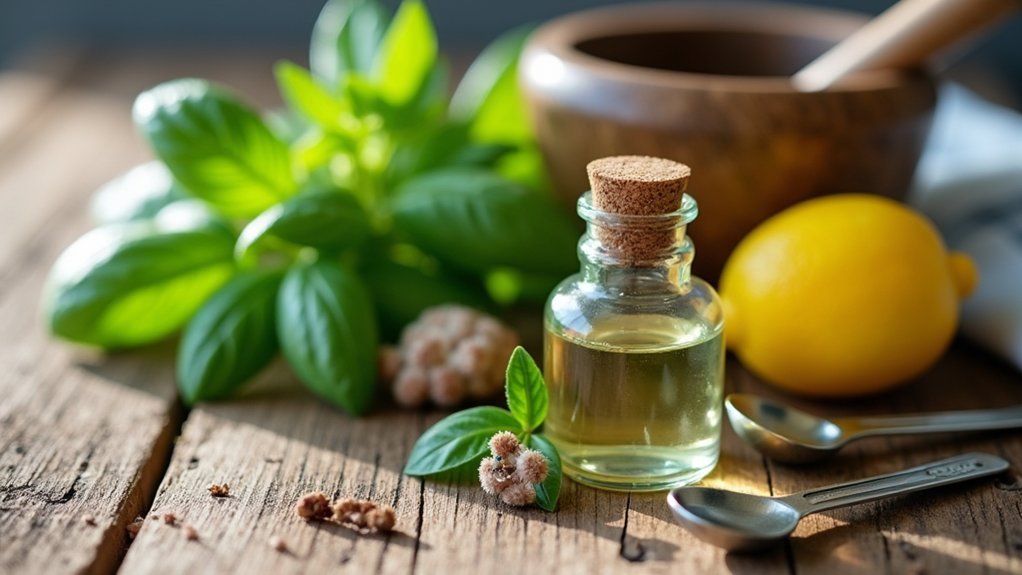



Leave a Reply